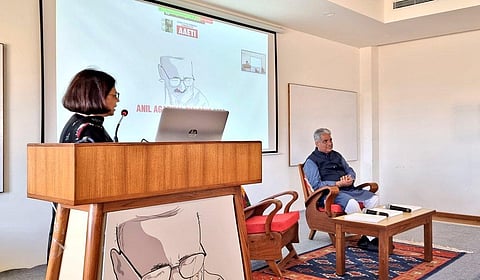

Bhupender Yadav, Union minister of environment, forests and climate change, released Down To Earth’s Annual State of India’s Environment Report 2022 at the Anil Agarwal Dialogue organised by Delhi-based non-profit Centre for Science and Environment (CSE) March 1, 2022.
“Reducing consumption and forming a self-restrained society is the only way that we can live with nature harmoniously,” Yadav said on the occasion.
The Anil Agarwal Dialogue is a four-day annual conclave of journalists. It is back in its physical form after a pandemic- and lockdown-induced hiatus of almost two years.
The event, which has over 60 journalists participating from across India, is being held at CSE’s state-of-the-art residential environmental training facility, the Anil Agarwal Environment Training Institute (AAETI), in Nimli, Alwar district, Rajasthan.
CSE director general Sunita Narain said: “In the last two years, the world has seen disruption at a scale not seen before. Both COVID-19 and climate change are the result of our ‘dystopian’ relationship with nature — call this the revenge of nature.”
COVID-19 happened because humans had broken the barrier between wild habitats and the way humanity produced its food. Climate change was the result of emissions needed for economic growth, Narain said.
“Both are also linked and are being exacerbated because of our mismanagement of health systems and the environment,” she added.
Yadav highlighted three extremely critical issues that confronted India today — climate change, desertification and the sustainability-affordability linkage.
He said:
We can change people’s lives by linking affordability with sustainability. We have to link traditional knowledge with scientific temperament; we sometimes are so proud of traditional knowledge that we forget logic. But we have to think of logic and affordability along with tradition to make it work.
Yadav stressed on the fact that his ministry was keen to have an “open debate on environment”. He said: “Our goals are the same: how to ensure a good life for everybody. We should learn from each other.”
Yadav pointed out that since emissions from the energy sector were the highest, the government was putting more emphasis on it.
He said:
By 2030, we plan to have 500 GW from renewable energy. Railways will be electrified by 2030 — that will reduce 80 billion tonnes of emissions. We also plan to employ LED bulbs at a large scale, which can reduce 40 billion tonnes of emissions. We are also focussing on hydrogen. If we can make hydrogen sustainable and affordable, we can bring big changes in the world.
The minister said environmental negotiations “is not about give and take — it is about saving humanity. The developed nations must take historic responsibility and consider what their ancestors have done in the past.”
Narain talked about the challenge of climate change.
She said: “India needs to act in its own self-interest. Our climate change strategy has to be based on the principle of co-benefits — we will do something for climate change because it is good for the world, but also because it is good for us.”
She added: “We need a low-carbon strategy for every sector; we must also ask the developed world to pay for and give us the high-cost options so that we can leapfrog.”